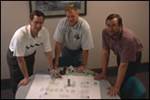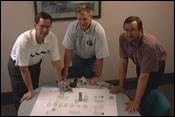The Custom Manufacturing Megatrend: A New Industrial Revolution
New methods of manufacturing are bringing about fundamental change in the way products are designed and delivered.
With advances in additive fabrication (AF), it is now possible to conceive a product and deliver it to a customer within days. As the custom manufacturing megatrend unfolds, anticipate the development of custom jewelry, collectables, personalized awards and corporate gifts, as well as custom design of medical implants, corporate aircraft interiors and high-end automobiles.
New-Generation Product Development
Products of today are designed and developed digitally and the 3-D model data is used to drive manufacturing machines and systems. This was not the case 100 or even 50 years ago. The Internet and 3-D printers (i.e., personal factories) are leveling the playing field, making it possible for almost anyone to manufacture and sell products locally or globally.
An example is Fabjectory, a one-person, home-based company that produces products from Nintendo Mii, Second Life and Google SketchUp. Avatars from Second Life cost $99 to $200, Mii models are $50 or $100 and SketchUp models are $50 to $150. The products are manufactured on a color 3-D printer from Z Corp.
Freedom of Creation (FOC) of the Netherlands designed some of the first lighting designs for Materialise.MGX, a division of Materialise (Belgium). FOC has since expanded into many areas using AF to manufacture fashion and home accessories, as well as giveaway products that would otherwise be prohibitively expensive to produce in such low quantities.
Janne Kyttanen, co-founder of FOC, explained that he has created CAD models of some new designs in a day or less, and began manufacturing them the following day—using laser sintering from EOS.
Cornell University’s open source development called Fab@Home has been used to create an assortment of objects. To date, most have been experimental. Materials include silicone rubber, cake icing, chocolate and cheese. For about $3,000, one can purchase a snap and screw together kit that produces parts using a syringe and nozzle system that extrudes materials. The system was used to create a silicone rubber version of Gumby. Electronics were embedded so that when pressing its belly, the eyes light up.
The Fab@Home system has not yet produced parts that one can expect from high-end additive systems, but part quality will likely improve as users fine-tune the system for specific materials.
In the future, AF will be used to produce custom food products. Already, the Fab@Home system has demonstrated that it is possible. The market for specialty foods is said to be $13 billion.
Aerospace
Parts for elaborate products, such as airplanes and spacecraft, are being manufactured with AF technology.
The new European-built Vega launcher includes FDM polycarbonate parts in each of the engines in all three stages of the rocket. The launcher puts 661 to 5,512 lbs (300 to 2,500 kg) satellites into polar and low-earth orbits. The Vega parts are being manufactured on a Stratasys Titan machine, according to Jorn Berends of JB Ventures BV in the Netherlands, the parent company of RapidPrototyping.NL. The parts serve as consumable igniters that contain the fuel for starting each rocket stage. Polycarbonate works well because it is rigid and strong, can withstand high temperatures, and burns away when necessary. “The parts are performing above expectations,” Berends says.
Dentistry
Dental labs supply crown and bridge work. The delivery of a crown is usually a week or two and involves many manual steps. The market for crowns and bridges in the U.S. is $8.5 billion.
Today, some dental labs are transitioning to methods of AF to speed the process and increase profit. Ex One has installed more than 30 Imagen RX-D machines at dental labs across the U.S. Using 3DP technology licensed from MIT, the machines jet binder onto fine, gold-alloy powder to produce gold copings. The copings are infiltrated with a lower melt temperature gold alloy to bring them to full density. They are then coated with porcelain to match the look of the patient’s teeth.
Gold is the preferred material in the U.S. for crowns, especially for teeth that are mostly visible. A gold coping, coated with a very thin layer of porcelain, produces a much more realistic looking replacement tooth, compared to dark metals. Cobalt-chrome (CoCr) is used extensively in some parts of the world for dental copings and can be produced on laser melting machines. With Selective Laser Melting from MTT (England), it is possible to manufacture 70 CoCr copings in eight hours. An EOSINT M 270 machine from EOS (Germany) can produce 380 CoCr copings in 20 hours. These numbers compare to 10 or so copings that a single dental technician can produce in an eight-hour day.
Summary
Volume manufacturing of standard products will not disappear, nor will most conventional methods of manufacturing; however, many new kinds of products will surface as people uncover the vast capabilities of additive fabrication.
A second industrial revolution, supported by the custom manufacturing megatrend, is beginning to unfold. The late Larry Rhoades once said, “This revolution will enable people to live where they’d like and produce what they need locally. People will pay for the plans and not the product.”
Sections of this article were taken from Wohlers Report 2008, a 240-page global review and analysis of the technologies, applications, products, companies, and markets associated with additive fabrication.
Related Content
What is Driving Mold Lifecycle Management Digitalization?
OEMs are looking to partner with suppliers to share and track data across the supply chain for advanced intervention and process management.
Read MoreMMT Chats: Solving Schedule and Capacity Challenges With ERP
For this MMT Chat, my guests hail from Omega Tool of Menomonee Falls, Wisconsin, who share their journey with using enterprise resource planning (ERP)—and their people—to solve their schedule and capacity load monitoring challenges.
Read MoreMaking Quick and Easy Kaizen Work for Your Shop
Within each person is unlimited creative potential to improve shop operations.
Read MoreThe Critical Role of Management Representatives in ISO 9001
In ISO 9001 quality management systems, the Management Representative (MR) plays a crucial role. While the 2015 version of ISO 9001 no longer mandates this position, having a trusted management member serve as an MR remains vital for streamlining operations and maintaining quality standards.
Read MoreRead Next
Mold Engineering Done Right
How your business can translate sophisticated, up-front engineering into better parts and fewer problems.
Read MoreReasons to Use Fiber Lasers for Mold Cleaning
Fiber lasers offer a simplicity, speed, control and portability, minimizing mold cleaning risks.
Read MoreHow to Use Strategic Planning Tools, Data to Manage the Human Side of Business
Q&A with Marion Wells, MMT EAB member and founder of Human Asset Management.
Read More

















